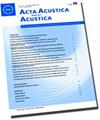Rating Level as a Method to Assess the Impact of Speech Noise on Cognitive Performance and Annoyance in Offices
Q1 Arts and Humanities
引用次数: 1
Abstract
In Germany, the rating level is an important parameter to assess noise immissions in occupied offices. The rating level denotes the energy-equivalent sound pressure level during a measurement period with speech sounds and considers penalties for tonal, informational and impulsive constituents. There is little evidence that the rating level correlates with the performance and perceived annoyance of office workers. This study evaluates 89 different sound conditions under which subjects have to complete a short-term memory task and a questionnaire in laboratory conditions with respect to their relationships with the rating level. The relationships of the penalty for impulsiveness and the penalty for tonality or informational constituents with the rating level are analyzed separately. In addition, the penalty for tonality or informational constituents is substituted by percentile level statistics, namely the difference between the 10th and 90th percentile levels. In contrast to the penalty for tonality or informational constituents, this metric is objectively measurable. Using the rating level to assess the noise at office workplaces could be improved by using percentile level statistics to account for informational constituents. To improve the predictive validity, it is suggested to report the penalties separately.评价语音噪音对办公室认知表现和烦恼影响的等级方法
在德国,等级等级是评估被占用办公室噪音排放的重要参数。评级等级表示在语音测量期间的能量等效声压级,并考虑音调,信息和脉冲成分的惩罚。几乎没有证据表明评级水平与办公室工作人员的表现和感知烦恼有关。本研究评估了89种不同的声音条件下,受试者必须在实验室条件下完成短期记忆任务和问卷调查,以了解他们与评级水平的关系。分别分析了冲动惩罚、调性惩罚和信息成分惩罚与评分水平的关系。此外,音调或信息成分的惩罚被百分位水平统计所取代,即第10和第90百分位水平之间的差异。与音调或信息成分的惩罚相反,这个度量是客观可测量的。使用评级水平来评估办公室工作场所的噪音可以通过使用百分位水平统计来说明信息成分来改进。为了提高预测的效度,建议将处罚分开报告。
本文章由计算机程序翻译,如有差异,请以英文原文为准。
求助全文
约1分钟内获得全文
求助全文
来源期刊
CiteScore
2.60
自引率
0.00%
发文量
0
审稿时长
6.8 months
期刊介绍:
Cessation. Acta Acustica united with Acustica (Acta Acust united Ac), was published together with the European Acoustics Association (EAA). It was an international, peer-reviewed journal on acoustics. It published original articles on all subjects in the field of acoustics, such as
• General Linear Acoustics, • Nonlinear Acoustics, Macrosonics, • Aeroacoustics, • Atmospheric Sound, • Underwater Sound, • Ultrasonics, • Physical Acoustics, • Structural Acoustics, • Noise Control, • Active Control, • Environmental Noise, • Building Acoustics, • Room Acoustics, • Acoustic Materials and Metamaterials, • Audio Signal Processing and Transducers, • Computational and Numerical Acoustics, • Hearing, Audiology and Psychoacoustics, • Speech,
• Musical Acoustics, • Virtual Acoustics, • Auditory Quality of Systems, • Animal Bioacoustics, • History of Acoustics.

 求助内容:
求助内容: 应助结果提醒方式:
应助结果提醒方式:


